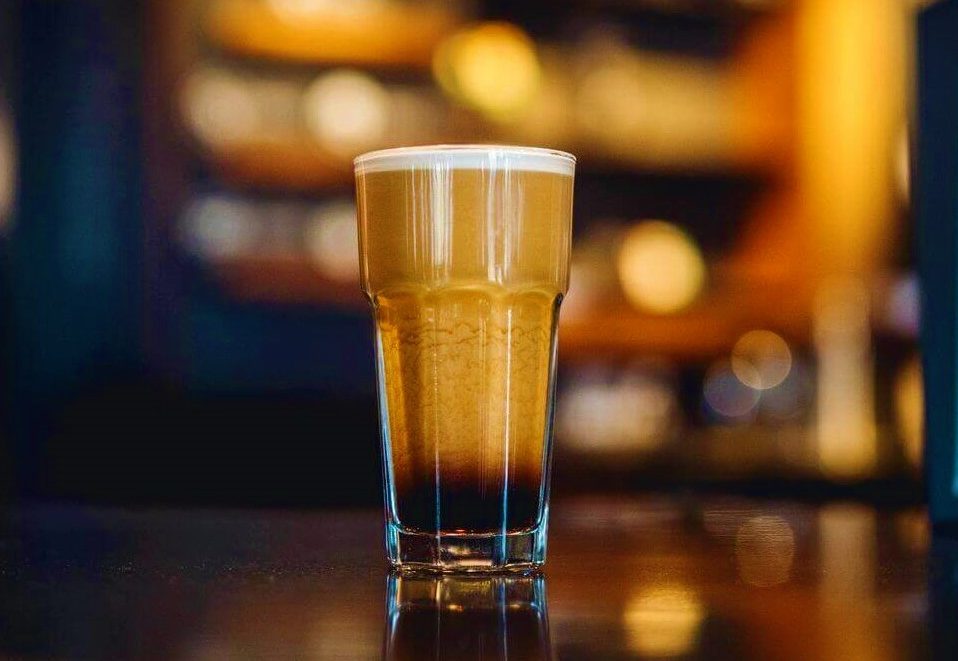Caffeine in Nitro Cold Brew vs Coffee: What’s the Buzz? In the ever-evolving landscape of caffeinated indulgence, two contenders have emerged to captivate the taste buds and fuel the daily grind – traditional coffee and the trendy Nitro Cold Brew.
As coffee enthusiasts seek the perfect elixir to kickstart their day, a question looms: What sets Nitro Cold Brew’s caffeine buzz apart from its conventional counterpart?
In this exploration of caffeinated delights, we dive into Nitro Cold Brew and coffee, unraveling the mysteries behind their distinct brewing processes, flavor profiles, and, most importantly, the intensity of their caffeine kicks.
Caffeine in Nitro Cold Brew vs Coffee: What’s the Buzz?
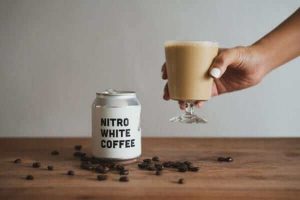
Join us on a journey through brewing alchemy as we dissect the nuances of these beloved beverages and discover which reigns supreme in caffeinated bliss.
It’s time to unravel the mysteries and decide: Does Nitro Cold Brew truly deliver a buzz transcending the classic cup of joe? Let’s find out.
What Is Nitro Cold Brew Coffee?
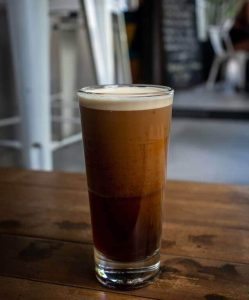
Nitro Cold Brew Coffee is a beverage that has taken the coffee world by storm, offering a unique and elevated experience for caffeine enthusiasts. This trendy drink is a variation of traditional cold brew coffee, but what sets it apart is the infusion of nitrogen, transforming it into a frothy, effervescent delight.
Here’s a breakdown of what Nitro Cold Brew Coffee is:
1. Cold Brew Coffee Base:
- Like its traditional counterpart, Nitro Cold Brew starts with a base of cold brew coffee. Cold brew is made by soaking coarsely crushed coffee beans in cold water for an extended period, usually 12 to 24 hours. This slow removal process produces a smoother and less acidic coffee concentrate than conventionally brewed coffee.
2. Nitrogen Infusion:
- Nitro Cold Brew’s distinctive character is the infusion of nitrogen gas. The cold brew coffee is typically stored in a keg or canister, and nitrogen is infused into the liquid under high pressure. This process creates tiny bubbles, imparting a creamy, almost beer-like effervescence to the coffee.
3. Creamy Texture and Frothy Head:
- The nitrogen infusion adds enthusiasm and creates a velvety and creamy texture. When poured from a tap or can, Nitro Cold Brew develops a cascading effect, culminating in a thick and frothy head reminiscent of a well-poured pint of stout.
4. No Added Ingredients:
- Nitro Cold Brew is often served without added sweeteners or cream. Its smooth and naturally sweet flavor profile and the creamy texture from nitrogen infusion make it a favorite among those who appreciate a clean and straightforward coffee experience.
5. Served Cold:
- As the name suggests, Nitro Cold Brew is served cold and is a refreshing option, especially popular during warmer months. The cold temperature, smooth flavor, and effervescent mouthfeel make it a sought-after alternative to traditional iced coffee.
6. Artisanal Presentation:
- Nitro Cold Brew is often served on tap, poured from a keg, or canned with a widget that releases nitrogen upon opening. The presentation adds an artisanal and visually appealing element to the coffee-drinking experience.
In summary, Nitro Cold Brew Coffee is a cold brew infused with nitrogen, resulting in a silky texture, enthusiasm, and a unique presentation. It’s a sensory delight that has become a staple in many coffee shops and is embraced by those seeking a refreshing and elevated twist on their daily caffeine fix.
1. How Does the Nitrogen Get into the Cold Brew Coffee?
Infusing nitrogen into cold brew coffee is a critical step in creating Nitro Cold Brew. This process involves pressurizing the coffee with nitrogen gas, typically using a nitrogen canister or a keg system. Here’s a step-by-step explanation of how nitrogen gets into cold-brew coffee:
1. Brew Cold Brew Coffee:
-
- The process starts with the creation of cold drink coffee. Coarsely ground coffee beans are steeped in cold or room temperature water for an extended period, gradually extracting the flavors and caffeine.
2. Transfer to a Keg or Canister:
-
- Once the cold brew is ready, it is transferred to a keg or canister designed for nitrogen infusion. These containers are typically sealed to maintain the freshness of the cold brew.
3. Pressurize with Nitrogen:
-
- Nitrogen gas, stored in a separate canister or tank, is then introduced into the keg or canister containing the cold brew. The process is similar to carbonating a beverage, but nitrogen is used instead.
4. High Pressure:
-
- Nitrogen is pressurized at a higher level than typical carbonation. This high pressure allows the nitrogen to dissolve into the cold brew, creating tiny bubbles and giving the coffee a creamy and effervescent texture.
5. Serve on Tap or Can:
-
- Once the nitrogen infusion is complete, Nitro Cold Brew can be served on tap or canned. When poured, the nitrogen creates a cascading effect, and the coffee develops a thick and frothy head, similar to the foam on a well-poured beer.
6. Widget Technology (for canned Nitro Cold Brew):
-
- A widget releases nitrogen upon opening in some canned Nitro Cold Brew products. The small pressurized capsule widget helps maintain the enthusiasm and creamy texture when the can is opened.
The nitrogen infusion enhances the texture and imparts a unique mouthfeel and flavor profile to the cold brew, making Nitro Cold Brew a distinctive and popular choice among coffee enthusiasts. The nitrogen infusion process is a carefully controlled technique that requires precision to achieve the desired effervescence and creaminess in the final product.
2. Nitro Cold Brew Nutrition Facts:
The nutritional content of Nitro Cold Brew can vary based on features such as the specific recipe, serving size, and any additional ingredients used. Here’s a general overview of the nutrition facts for a standard serving of Nitro Cold Brew:
Typical Nutritional Content (per 16 oz serving):
- Calories: Approximately 5-10 calories (without added sweeteners or cream)
- Total Fat: Negligible
- Saturated Fat: Negligible
- Trans Fat: 0g
- Cholesterol: 0mg
- Sodium: 5-10mg
- Total Carbohydrates: 0-1g
- Dietary Fiber: 0g
- Sugars: 0g
- Protein: 0g
- Caffeine Content: Higher than traditional coffee due to the concentrated nature of cold brew, but exact amounts can vary.
Additional Considerations:
- Added Ingredients: The calorie and sugar content will increase if sweeteners or cream are added to the Nitro Cold Brew. Some variations may include sweetened flavored syrups or dairy alternatives.
- Dietary Preferences: Nitro Cold Brew is often enjoyed black, but variations with added ingredients may be available to accommodate different dietary preferences, such as dairy-free or sugar-free options.
As nutritional content can differ between brands and recipes, you should check the product’s nutritional information or inquire at the coffee shop where you purchase your Nitro Cold Brew for the most accurate details.
Caffeine in Nitro Cold Brew:
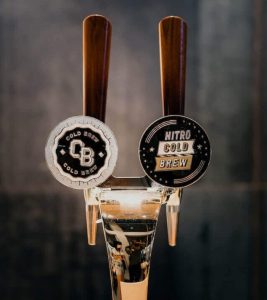
The caffeine content in Nitro Cold Brew can vary based on features such as the coffee bean type, brewing strength, and serving size. Nitro Cold Brew is known for having a higher caffeine concentration than traditional hot-brewed coffee because it is often made using a cold brew concentrate.
As a general guideline:
- Cold Brew Concentrate: Cold brew coffee, in general, tends to have a higher caffeine concentration because it is prepared using a higher coffee-to-water ratio and steeped for an extended period. The cold brewing process extracts caffeine more slowly but efficiently, producing a potent concentrate.
- Nitrogen Infusion: While nitrogen does not contribute to the caffeine content, it enhances the drinking experience by creating a creamy texture and effervescence. The nitrogen infusion is a unique feature of Nitro Cold Brew, contributing to its popularity.
- Caffeine Range: A typical 16-ounce (Grande size) serving of Nitro Cold Brew can contain anywhere from 200 to 400 milligrams of caffeine, although these numbers vary. It’s important to note that this is a general range, and the actual caffeine content can differ based on features such as the coffee blend used and the brewing process.
- Higher Caffeine Concentration: Nitro Cold Brew is often appreciated for its strong and bold flavor, making it a favorite among those seeking a powerful caffeine kick.
It’s advisable to check with the specific coffee shop or manufacturer for precise information on the caffeine content of their Nitro Cold Brew, as formulations can differ between brands. Additionally, individuals sensitive to caffeine should be mindful of their intake, considering the higher concentration found in Nitro Cold Brew.
1. What About Nitro Cold Brew vs. Traditional Cold Brew?
Nitro Cold Brew and traditional Cold Brew share a common starting point – both are made by soaking tastelessly ground coffee beans in cold water for a lengthy period. However, they differ significantly in terms of texture, presentation, and, to some extent, flavor.
Let’s explore the distinctions between Nitro Cold Brew and traditional Cold Brew:
1. Texture and Mouthfeel:
- Nitro Cold Brew:
- Infused with nitrogen, Nitro Cold Brew has a velvety, creamy texture that is often compared to a well-poured stout or a draft beer. The nitrogen infusion creates tiny bubbles, producing a smooth and effervescent mouthfeel.
- Traditional Cold Brew:
- Traditional Cold Brew, while still smooth, lacks the nitrogen-induced creaminess. It tends to have a straightforward, slightly syrupy consistency.
2. Presentation:
- Nitro Cold Brew:
- Served on tap or from a can, Nitro Cold Brew has a visually appealing cascading effect when poured, developing a thick and frothy head.
- Traditional Cold Brew:
- Typically served over ice, traditional Cold Brew lacks the cascading presentation associated with nitrogen infusion.
3. Flavor:
- Nitro Cold Brew:
- The nitrogen infusion can slightly alter the flavor profile, enhancing sweetness and contributing to a well-rounded and balanced taste. Some may detect a subtle sweetness even without added sugar.
- Traditional Cold Brew:
- Known for its bold, concentrated flavor, traditional Cold Brew tends to showcase the natural notes of the coffee beans with minimal interference from other factors.
4. Caffeine Content:
- Nitro Cold Brew:
- Often, it has a higher caffeine concentration due to the use of a cold brew concentrate and the perceived strength of the beverage.
- Traditional Cold Brew:
- Although still strong, traditional Cold Brew may have a slightly lower caffeine concentration than Nitro Cold Brew.
5. Serving Style:
- Nitro Cold Brew:
- Served on tap or from a can, providing a unique and artisanal experience.
- Traditional Cold Brew:
- Helped over ice or diluted with water or milk, depending on individual preferences.
In summary, Nitro Cold Brew offers a distinctive and visually striking experience with its creamy texture and effervescent presentation. At the same time, traditional Cold Brew leans towards a straightforward and bold coffee flavor.
Preferences between the two often come down to personal taste, with some favoring the enhanced texture and presentation of Nitro Cold Brew and others appreciating the simplicity of traditional Cold Brew.
Starbucks Nitro Cold Brew:
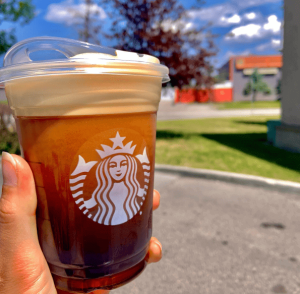
Starbucks offers Nitro Cold Brew as part of its beverage menu. Starbucks Nitro Cold Brew is a cold coffee option infused with nitrogen, delivering a creamy and effervescent texture. Here are some critical points about Starbucks Nitro Cold Brew:
Key Features:
- Nitrogen-Infused: Starbucks Nitro Cold Brew is created by infusing cold brew coffee with nitrogen, resulting in a smooth and velvety texture with tiny bubbles.
- No Added Ingredients: The classic Starbucks Nitro Cold Brew is typically served without added sweeteners or cream. It emphasizes the coffee’s natural flavors and nitrogen infusion’s effects.
- Presentation: Starbucks Nitro Cold Brew is often served on tap from a keg or through a unique tap system at Starbucks stores. The presentation includes a cascading effect when poured, leading to a frothy head on top of the beverage.
- Seasonal Variations: Starbucks may introduce seasonal variations or limited-time offerings that include flavored syrups, sweet cream, or other additions to complement the Nitro Cold Brew base.
- Availability: Availability may vary depending on the Starbucks location, and not all Starbucks stores may have Nitro Cold Brew on their menu.
- Caffeine Content: Starbucks Nitro Cold Brew tends to have a higher caffeine concentration than traditional iced coffee due to the cold brew base and the nitrogen infusion.
Ordering:
When ordering Starbucks Nitro Cold Brew, you can specify your preferred size (Tall, Grande, Venti) and ask for any customizations you desire, such as adding sweet cream or flavored syrups if available.
Please note that specific offerings and menu items at Starbucks can change, and it’s advisable to check with your local Starbucks store or the official Starbucks website for the most up-to-date information on their Nitro Cold Brew options and any new variations they may have introduced since my last update.
1. Does Adding Milk or Cream Change Caffeine Levels?
No, adding milk or cream to coffee does not change the caffeine levels. Caffeine is a water-soluble compound whose concentration remains constant regardless of whether you add milk, cream, or any other liquid to your coffee.
The perception of a change in caffeine levels may arise from the dilution effect. When you enhance milk or cream to your coffee, you dilute the caffeine concentration per ounce or milliliter of the beverage. However, the total amount of caffeine in the coffee remains the same; it is just distributed in a larger volume.
For example, if you have a cup of black coffee with a certain amount of caffeine and then add milk to it, the caffeine content per ounce of the entire mixture is reduced because you’ve increased the volume by adding milk. However, the total amount of caffeine in the cup hasn’t changed.
It’s important to note that the change in taste and texture resulting from adding milk or cream can influence your overall coffee-drinking experience. Still, it doesn’t impact the inherent caffeine content of the coffee itself. If you’re looking to control your caffeine intake, it’s advisable to be mindful of the total volume of the beverage rather than the presence of milk or cream.
2. Caffeine Levels of Canned Starbucks Options:
Starbucks offers a variety of canned coffee and cold brew options in grocery stores and other retail locations. The caffeine content in these canned beverages can vary based on the specific product, serving size, and any additional ingredients or flavorings. Below are some general guidelines for the caffeine levels in a few popular canned Starbucks options:
Starbucks Doubleshot Espresso & Cream:
- Caffeine Content: A 15 fl oz (443 mL) typically contains around 150 mg of caffeine.
- Ingredients: Brewed Espresso Coffee (Water, Coffee), Reduced-Fat Milk, Sugar.
Starbucks Nitro Cold Brew:
- Caffeine Content: A 9.6 fl oz (283 mL) typically contains around 215 mg of caffeine.
- Ingredients: Coffee (Water, Coffee), Nitrogen.
Starbucks Tripleshot Energy:
- Caffeine Content: A 15 fl oz (443 mL) typically contains around 225 mg of caffeine.
- Ingredients: Brewed Starbucks Coffee (Water, Coffee), Skim Milk, Sugar, Maltodextrin, Natural Flavors, Taurine, Panax Ginseng Root Extract, L-Carnitine, Inositol, Guarana Extract.
Starbucks Cold Brew Coffee:
- Caffeine Content: An 11 fl oz (325 mL) bottle typically contains around 200 mg of caffeine.
- Ingredients: Cold Brew Coffee (Water, Coffee).
These approximate values can vary based on product variations and regional differences. It’s crucial to check the specific product label for the most accurate and up-to-date information on caffeine content and ingredients.
Additionally, Starbucks may introduce new products or adjust formulations, so it’s good to check with the manufacturer or Starbucks directly for the latest details.
3. Does Starbucks Nitro Cold Brew Have More Caffeine than Espresso?
Yes, Starbucks Nitro Cold Brew typically has more caffeine than a standard shot of espresso. The higher caffeine content in Nitro Cold Brew is due to combining two factors: the cold brew coffee base and the nitrogen infusion.
Here’s a general comparison:
Nitro Cold Brew:
-
- A serving of Nitro Cold Brew is often made using a cold brew concentrate, which involves soaking tastelessly ground coffee beans in cold water for an extended period. This concentrated cold brew is then infused with nitrogen, resulting in a creamy and effervescent texture.
- The caffeine content in Nitro Cold Brew can range from approximately 200 to 400 milligrams or more per 16-ounce serving, depending on factors such as the specific recipe, coffee bean type, and brewing strength.
Espresso:
-
- A standard shot of espresso is generally smaller in volume (about 1 ounce or 30 milliliters) and is brewed using hot water forced through finely ground coffee under high pressure.
- A single espresso shot consists of about 63 mg of caffeine, while a dual shot has approximately 125 milligrams. These values can vary based on the coffee bean type and the brewing process.
In summary, while the exact caffeine content can vary, Nitro Cold Brew tends to have a higher caffeine concentration than a standard shot of espresso due to the cold brew concentrate and nitrogen infusion. Nitro Cold Brew might be the preferred choice if you’re looking for a strong caffeine kick.
Impact of Caffeine on the Body:

Caffeine is a usual stimulant found in numerous plants, and it is commonly consumed in beverages like coffee, tea, and energy drinks. While moderate caffeine consumption is usually considered safe for most people, it can have various effects on the body. Here are some key impacts of caffeine:
1. Stimulant Effect:
- Central Nervous System: Caffeine acts as an essential nervous system stimulant. It blocks the act of adenosine, a neurotransmitter responsible for promoting relaxation and sleepiness. This leads to increased alertness and reduced perception of fatigue.
2. Improved Cognitive Function:
- Alertness and Concentration: Caffeine has been shown to enhance cognitive functions such as alertness, concentration, and reaction time.
3. Mood Enhancement:
- Release of Neurotransmitters: Caffeine can stimulate the release of neurotransmitters like dopamine, contributing to improved mood and a sense of well-being.
4. Physical Performance:
- Stimulation of Adrenaline: Caffeine stimulates the release of adrenaline, preparing the body for physical exertion. This can enhance physical performance and endurance.
5. Metabolism and Fat Burning:
- Increased Metabolic Rate: Caffeine can temporarily increase metabolic rate, promoting fat burning. This is why caffeine is a common ingredient in many weight loss supplements.
6. Diuretic Effect:
- Increased Urination: Caffeine has a mild diuretic effect, increasing urine production. However, regular coffee drinkers tend to develop a tolerance to this effect.
7. Improved Respiratory Function:
- Bronchodilation: Caffeine can act as a bronchodilator, opening airways and improving respiratory function. It is sometimes used in the treatment of asthma.
8. Blood Pressure and Cardiovascular Effects:
- Temporary Blood Pressure Increase: Caffeine can cause a temporary increase in blood pressure, but this effect tends to be more pronounced in non-regular consumers. Some studies suggest that habitual coffee drinkers may develop a tolerance to this effect.
9. Withdrawal Symptoms:
- Dependency and Withdrawal: Regular consumption of caffeine can lead to physical dependence, and abrupt cessation can result in withdrawal symptoms such as headaches, irritability, and fatigue.
10. Sleep Disruption:
- Insomnia: Caffeine can interfere with sleep, particularly if consumed later in the day. It can reduce the value of sleep and contribute to insomnia in sensitive individuals.
11. Individual Variability:
- Response Variation: Individual responses to caffeine can vary significantly. Genetics, tolerance, and sensitivity influence how people react to caffeine.
12. Health Considerations:
- Moderation is Key: While moderate caffeine intake is generally safe for adults (about 200–400 mg daily), excessive consumption can lead to adverse effects, including jitteriness, increased heart rate, and digestive issues.
It’s essential for individuals to be mindful of their caffeine intake and to recognize how it may impact their own body and health. Those with certain medical conditions or caffeine sensitivity should consult healthcare professionals for personalized advice.
How to Make Nitro Cold Brew at Home?
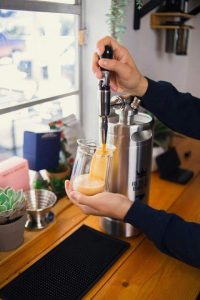
Making Nitro Cold Brew at home is a rewarding process that allows you to enjoy the smooth and creamy texture of nitrogen-infused cold brew coffee without leaving your kitchen. Here’s a step-by-step guide on how to make Nitro Cold Brew at home:
Ingredients:
- Coarsely ground coffee beans
- Cold, filtered water
- Nitrogen canister (with the appropriate kegging system)
- Nitrogas (usually a mix of nitrogen and carbon dioxide)
- Optional: Sweeteners, milk, or flavorings, depending on your preference
Equipment:
- Cold brew coffee maker or a large jar
- Fine mesh strainer or coffee filters
- Kegging system with a nitrogen canister
- Nitro tap or stout faucet
- Nitro gas cartridge
Instructions:
-
Cold Brew Concentrate:
- Coarsely grind your favorite coffee beans. Use a ratio of about 1 cup of coffee grounds to 4 cups of cold, drinkable water.
- Combine the coffee grounds and water in a cold brew coffee maker or a large jar.
- Stir the mixture, ensuring all coffee grounds are saturated.
- Seal the container and let it steep in the refrigerator for 12 to 24 hours.
-
Strain the Cold Brew:
- After steeping, strain the cold brew concentrate using a well-mesh strainer or coffee filter to remove the coffee grounds. The result is a smooth and concentrated cold brew.
-
Prepare the Nitro Keg:
- Transfer the cold brew concentrate into a keg suitable for nitrogen infusion.
- Attach the nitrogen canister to the keg, ensuring a secure seal.
- Charge the keg with nitro gas according to the manufacturer’s instructions.
-
Infuse with Nitrogen:
- Allow the cold brew to sit in the keg with nitrogen for at least 24 hours to ensure proper infusion. The longer it sits, the creamier the touch will be.
-
Pour and Enjoy:
- Connect the keg to a nitro tap or stout faucet. Pour the Nitro Cold Beverage into a glass, allowing the nitrogen to create a cascading effect and a frothy head.
-
Customize (Optional):
- Add desired sweeteners, milk, or flavorings to your Nitro Cold Brew. Experiment to find the perfect stability for your taste.
-
Serve Chilled:
- Nitro Cold Brew is best enjoyed over ice or chilled for a refreshing experience.
Tips:
- Use high-quality, freshly ground coffee beans for the best flavor.
- Experiment with the coffee-to-water ratio to find your preferred strength.
- Adjust the infusion time based on your desired level of creaminess.
- Keep equipment clean and sanitized to maintain the quality of your Nitro Cold Brew.
By following these steps, you can create a delicious and artisanal Nitro Cold Brew right in the comfort of your home.
Conclusion:
In the captivating world of caffeinated delights, the Nitro Cold Brew and traditional hot-brewed coffee are titans, each offering a unique symphony of flavors and textures. As we’ve journeyed through the nuances of these two beloved beverages, it becomes clear that the choice between Nitro Cold Brew and coffee is more than a matter of preference; it’s an exploration of the diverse realms of coffee craftsmanship.
The Nitro Cold Brew beckons those seeking a refreshing and indulgent experience with its velvety texture and effervescent charm. Its nitrogen infusion transforms the coffee ritual into a sensory adventure, enticing the eyes and the palate.
So, what’s the buzz? It’s the harmonious coexistence of innovation and tradition, enthusiasm and warmth, encapsulated in every sip. Whether you find yourself drawn to the silky cascade of nitrogen-infused brew or the comforting embrace of a hot cup, the world of coffee invites you to explore, savor, and celebrate the richness each cup brings to your daily caffeine ritual. Cheers to the endless possibilities and the buzz accompanying every encounter with the world’s favorite pick-me-up.
FAQs:
How Much Caffeine Is in Peets, Dunkin, and Dutch Bros Nitro Cold Brew?
Caffeine Content in Nitro Cold Brew: Peet’s, Dunkin’, and Dutch Bros
Peet’s Coffee:
Peet’s doesn’t explicitly state the caffeine content of its nitro cold brew on its website. However, the caffeine levels are closely tied to its Baridi Blend cold brew. The Baridi Blend iced coffee, served over ice, ranges between 113 mg and 187 mg, depending on cup size. Since nitro cold brew skips the ice, the caffeine content tends to be higher, potentially approaching double the amount found in a standard cold brew coffee.
Dunkin’ (formerly Dunkin’ Donuts):
Dunkin’ doesn’t provide specific caffeine information for its nitro cold brew on its official website. However, consensus suggests that Dunkin’s nitro cold brew contains around 17.5 mg of caffeine per ounce. This estimate puts a 16-ounce cup at approximately 280 mg of caffeine.
Dutch Bros Coffee:
Like the others, Dutch Bros doesn’t disclose the caffeine content of its nitro cold brew on the company’s website. However, the canned version’s caffeine content exceeds 25 mg per ounce, establishing a robust baseline for the caffeine concentration in their nitro cold brew.
Is There Hot Nitro Coffee?
Traditionally, nitro coffee is associated with cold brew coffee infused with nitrogen and served cold, resulting in a smooth and effervescent beverage. The nitrogen infusion creates a creamy texture and a cascade of tiny bubbles, giving the cold brew a unique and appealing quality.
However, the term “nitro” refers to the infusion of nitrogen gas, and this infusion method is not exclusive to cold beverages. Some coffee shops and experimental brewers have explored the concept of hot nitro coffee, applying the nitrogen infusion process to hot coffee.
The idea behind hot nitro coffee is to bring the creamy and velvety texture associated with nitrogen infusion to the hot coffee experience. The result is a hot coffee with a smooth and frothy top layer, similar to the head found in a well-poured pint of beer.
Hot nitro coffee is not as standard as its cold counterpart, but it showcases the versatility of nitrogen infusion in enhancing different coffee experiences. Suppose you’re interested in trying hot nitro coffee. In that case, it’s a good idea to check with local specialty coffee shops or inquire with your favorite coffee roasters, as it might be a specialty item offered in select locations. Remember that trends and offerings can vary, so that that availability might change.
Is Nitro Cold Brew Keto?
Nitro Cold Brew, in its purest form without added sugars or sweeteners, can be considered keto-friendly. The beverage consists of cold brew coffee infused with nitrogen, creating a smooth and creamy texture without the need for additives containing carbohydrates.
However, it’s crucial to note that the keto-friendliness of Nitro Cold Brew depends on how it’s prepared and any additional ingredients included. Here are some key points to consider:
- Plain Nitro Cold Brew: If you order or make plain Nitro Cold Brew without added sugars, sweeteners, or high-carb additives, it is low in carbohydrates and can fit into a ketogenic (keto) diet.
- Flavorings and Additives: Some coffee shops or packaged Nitro Cold Brew products may offer flavored variations, including sugar or syrups. It’s essential to check the ingredients and nutritional information to ensure no added sugars or high-carb components.
- Dairy or Cream Additions: If you choose to add dairy or cream to your Nitro Cold Brew, consider the carb content of these additions. Heavy cream and certain non-dairy alternatives are low in carbs and are commonly used in keto diets.
- Watch for Hidden Sugars: Avoid flavored syrups, sweetened creamers, or other hidden sugar additives. These can contribute to carb intake and impact ketosis.
- Homemade Nitro Cold Brew: Making Nitro Cold Brew at home allows you to control the ingredients. Following a keto diet, you can prepare it using low-carb sweeteners or enjoy it black.
As with any diet, it’s crucial to be mindful of your overall carbohydrate intake and how specific foods or beverages fit into your daily carb limit. Checking nutritional information and ingredient lists when purchasing Nitro Cold Brew and making informed choices can help you maintain a ketogenic lifestyle.

